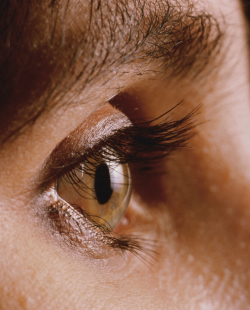Upper lid blepharoplasty probably is the most frequently performed type of plastic surgery. But most patients do not want to change their ‘look’ . So the (oculo)plastic surgeon has to watch carefully the patients lid crease in the upper lid before starting any surgery. Moreover, most patients are very specific and concrete about their desires and expectations. An Expert explains Health First Magazine.
And of course, if patients had a high lid crease in the past, we have to try to restore this situation with our blepharoplasty. Furthermore there is a third group of patients with a true blepharoptosis, i.e. with a real lower lid margin that sometimes even (partially) covers the pupil. These patients may just want their eyelids to be lifted without altering the character of the lids. Here the skin incision must be lower, either in a preexisting crease or, if the patient does not have a crease at all, not higher than 4 to 5 mm above the lid margin.
Also the contralateral lid crease incision must be measured to be reproduced to the same extent.
So every procedure must be individualized for each patient and his of her desires must be discussed before surgery.
It is also important that the patients know the limitations of the intervention. On the other hand in most cases small changes will already give excellent results. So I recommend only subtle, very natural changes in the height and contour of the upper lid crease.
With the patient in upright position the upper lid incision and the skin area to be resected is demarcated with a surgical pencil.
Then the patient is put in supine position and a subcutaneous infiltration with anesthetic is performed.All incisions are done with a Radiosurgery unit because in this way the incision is pressureless and that gives the best results especially for the delicate skin of the upper eyelid..
Moreover, Radiosurgery limits the bleeding and swelling during and after the surgery. The result is a faster recovery. Some patients may have greater propensity for hypertrophic scarring and that is another reason to use Radiosurgery instead of a scalpel or a CO2 laser.
Contrary to conventional surgery I do not start the intervention with a deep skin-muscle resection but only perform a very superficial skin excision.
After that, I switch to a different, more coagulating radiosurgical wave , not only to contract the underlying orbicularis muscle to accentuate the lid crease but also to push the fat pockets back into the orbit instead of removing them.
Only in very rare cases the orbicularis muscle is incised to perform a (very) conservative fat resection. The muscle is sutured with a few absorbable sutures. The skin is closed with separate sutures that can be taken out after already 6 days.
A cooling mask is put on the eyes to prevent swelling and eventual postop bleeding.
The surgery itself only takes about 45 minutes. The patient stays in the recovery room for another 30 minutes and then returns home. Sutures can be taken out after 6 days.
Patients’ acceptance of this type of surgery is excellent and because in most cases the muscle does not need to be incised, the risks and complications of this type of upper lid blepharoplasty are minimal.
About Peter Raus
He is a Belgian Oculoplastic Surgeon. He was trained in Belgium (Louvain), Spain (Barcelona) and Egypt (El Mansourah). Peter had additional surgical training with Dr. Stephen Bosniak. Al his surgery is performed with the Ellman Radiosurgery unit. The interventions under local anaesthesia are done in his own Miró Center; patients who require general anaesthesia can be operated in the nearby Heilig Hart Ziekenhuis. He developed his own techniques of blepharoplasty and recently he developed a new surgical clamp for ectropium surgery. It has a CA and FDA label; the patent os pending. Together with professor Juan Murube from Madrid he developed a surgical technique for patients with very dry eyes. In those cases he transplants labial salivary glands from the lower lip to the eyelid.Peter has been an invited speaker at conferences in more than 20 different countries.He his a member of the board of several national and international professional organisations.In the Miró center people from all over the world are treated.




